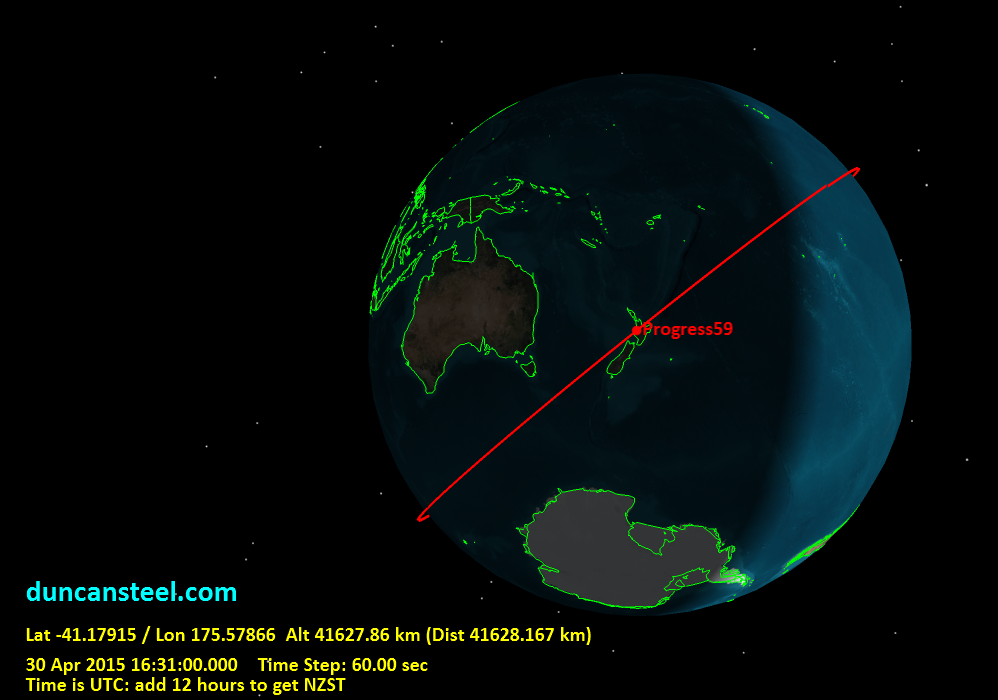A Russian spacecraft due to deliver supplies to the International Space Station has failed in its mission and is now spinning uncontrollably as it orbits Earth.
 The unpiloted Progress 59 spacecraft encountered problems when it reached orbit and separated from the Soyuz rocket booster’s third stage, as reported at Stuff.co.nz.
The unpiloted Progress 59 spacecraft encountered problems when it reached orbit and separated from the Soyuz rocket booster’s third stage, as reported at Stuff.co.nz.
Russian officials scrambled to communicate with the spacecraft, which was carrying 272kg of food, fuel and supplies to the space station, but were unable to gain control of it. As a result, the spacecraft is now spinning at a rate of 360 degrees every five seconds.
The SMC collected the following expert commentary. Feel free to use these quotes in your reporting. If you would like to contact a New Zealand expert, please contact the SMC (04 499 5476; smc@sciencemediacentre.co.nz).
Dr. Duncan Steel, New Zealand-based Space Scientist at NASA-Ames Research Center, Professor of Astrobiology at the University of Buckingham and Astronomer at Armagh Observatory, comments:
“The capsule is out of control and apparently has spawned various debris items, indicating a likely explosion of some description. The observation that the capsule is spinning or tumbling every few seconds is additional evidence for some catastrophic event/malfunction. These things happen! Because of the low altitude of the capsule, it is very unlikely that a collision with a piece of space junk was responsible. Most likely it was an onboard malfunction.
“The capsule was ferrying some tons of food, water, oxygen and other supplies to the International Space Station (ISS). Loss of this capsule is not a disaster: the astronauts will not run out of anything soon. But of course there is an economic cost. There are other means by which the ISS is resupplied, in particular commercial launches from the US by SpaceX.”
What will happen to this spacecraft and how might this affect us on Earth?
“The perigee (lowest altitude) of the present orbit of the capsule is about 186 km. Although the atmosphere is very tenuous there (about one part in a trillion of that at sea level) the high speed of the capsule (around 8 kilometres per second, or 288,000 km/hour) causes significant drag, slowing the capsule down. Eventually – over the next few weeks – the capsule is expected to lose altitude until such time as it re-enters the denser atmosphere below and then falls to the ground (or, more likely, into the ocean somewhere).
“Because the capsule is apparently out of control it appears that it will not be possible to arrange re-entry over an unpopulated region (such as the middle of the Pacific). Therefore there is a small but finite risk that someone might get hit, or some property damage might occur. To put things in context, this capsule has a mass of a few tons/tonnes; whereas the mass of natural meteoroids entering the upper atmosphere every day is about 100 tonnes. In recent times (the past century or so) no-one has been killed by a meteorite, although a lady was badly bruised by one in Alabama in the 1950s. There is also a story, perhaps apocryphal, that a dog was killed by a falling meteorite in Egypt in 1910. No-one has ever been hit by falling man-made space junk, such as this capsule.”
Will the spacecraft be visible in New Zealand’s night skies?
“In principle one can see orbiting satellites (including this one) from anywhere that is clear in NZ, although far from city lights (and clouds!) is best.
“However, to see a satellite one must be in a location and time such that the satellite is above the horizon for you, and also it is near to dusk or dawn but the sky is mostly dark. The reason for this is that the Sun must be illuminating the satellite for you to be able to see it: thus the condition is that the Sun must have set for you (on Earth’s surface) but the Sun has not yet set for the satellite (which is high up, obviously). It happens that none of the passes of Progress 59 over NZ in the next couple of days is at a suitable time: the passes occur during nighttime, so the satellite is not illuminated by the Sun.
“As a general recommendation, people who want to spot satellites in the sky – and it’s easy, some are really bright! – should visit the website heavens-above.com. That is a free resource, where you can enter your geographical location and the site will tell you which satellites are visible, and where and when to look.”